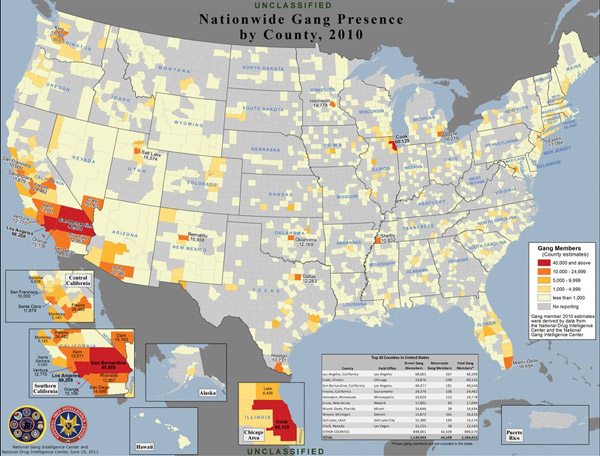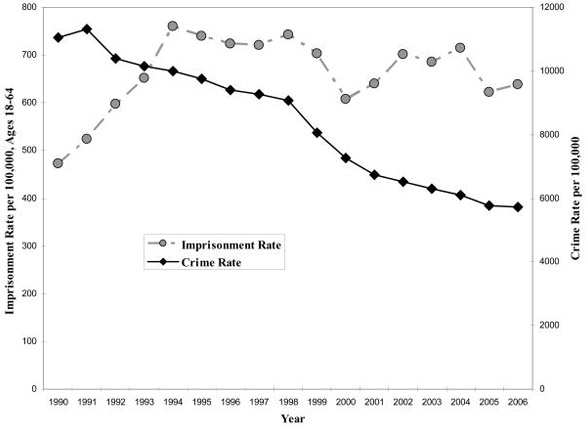The latest Chicago Crime Commission gang report is out, and it totals an enormous number of gang members in Chicago—68,000 or more. According to Jody Weis, who now runs the Commission, that makes Chicago the most gang-ridden city in the country. That's not what the FBI found in its 2011 gang assessment, but the numbers aren't far off: the feds had Los Angeles at number one in 2010 with over 68,000, and Chicago/Cook County in second with just over 60,000 (larger, mostly legible version here).

Either way, it's still a surprising statistic, given that Chicago has far more gang members than New York, Miami, Dallas, Houston, or any other major city besides Los Angeles. The disparity between New York and Chicago is particularly surprising; despite its vast size, New York has less than a third the number of Chicago's gang members.
One of the more compelling arguments for why Chicago's gang problem has persisted so long in the face of New York's relative success is the city's approach to public housing. In a 2001 piece for The American Prospect, U. of C. sociologist Sudhir Venkatesh compared New York public housing favorably with Chicago:
Chicago's current residential patterns in public housing are a legacy of the segregationist strategy of the first Mayor Daley, who offered public housing to blacks as a form of patronage, with the proviso that it be divided along racial lines. New York's most successful public housing developments are economically integrated. Chicago's, in contrast, only house poor and nonworking families. While Chicago's public housing tenants have extraordinarily high rates of welfare recipiency (92 percent in Robert Taylor receive either public assistance or a benefit such as disability or Social Security), few of New York's tenants are on welfare. In the mid-1980s, for example, when the national rate was 44 percent, only 27 percent of New York tenants were on the welfare rolls, the lowest in the country at the time.
John Hagedorn, a UIC expert on gangs, goes into even more detail (PDF):
However, in 1985, after a struggle over the effects of the fiscal crisis and the Reagan-era gutting of the federal Housing and Urban Development budget, NYC Mayor Koch announced the largest urban housing initiative in the history of the United States—a commitment of $4 billion dollars to build or renovate more than 100,000 housing unites over 5 years. The actual expenditures turned out to be larger- more than $5 billion and 182, 000 units (Shill et al. 2002). One result was the reversal of the trend of depopulation in areas like the South Bronx, who saw a 11% gain in population in the 1990s and a reversal of its reputation as a US “Beirut” to a “Comeback City (Grogan and Proscio 2000).
[snip]
Whatever impact housing investment may have played on crime rates in NYC, the refurbishing of housing in the South Bronx and elsewhere did not result in the displacement of residents. Rather, in New York’s tight housing market, people wanted to stay in their neighborhoods and wanted to stay even more as they improved. In Chicago, while most tenants wanted to stay in their homes and have them fixed, CHA policy forced them to move.
[snip]
The “Plan for Transformation” (CHA 2000) of Chicago’s public housing reads as the exact reverse New York City’s earlier Ten Year Plan in several respects. The renovating of the South Bronx and other deteriorated ghetto lands in NYC meant making the neighborhoods a more attractive place for current residents to live. In Chicago, demolition of public housing is resulting in the displacement of more than a hundred thousand African Americans. Even with many displaced tenants entering Lawndale and Englewood, both neighborhoods continued in the 1990s to see more than 11% and 18% population loss respectively, the reverse of the South Bronx.
The timing of Koch's initiative, in the mid-1980s, is significant. As New York was in the midst of its reinvention of its urban housing, Chicago was desperately trying to save its own, with no success, as Susan Popkin and David Price wrote in 2010:
Decades of failed federal policies, managerial incompetence, financial malfeasance, and basic neglect had left these developments in an advanced state of decay, with overwhelming crime and violence and near-absolute gang dominance. During the 1990s, the CHA had fought an all-out war against the drug trafficking and violence in its developments, spending $500 million on such efforts as law enforcement “sweeps” intended to remove drug dealers and gangs from its buildings, in-house police and security forces, and tenant patrols, none of which had any lasting effect on the crime and disorder (Popkin et al. 2000).
In American Project, Venkatesh gives reasons for the failure of tenant patrols and security—essentially, they couldn't compete with the gangs, so they worked with them to minimize risk. As Venkatesh points out, this parallels with prison treatment of gang members amidst another fateful public policy trend that would also concentrate gang members in populous, dangerous places: increasing incarceration beginning in the 1970s:
The greatest expansion of street-gang activity was a direct result neither of poverty nor of the burgeoning crack economy. It was an outgrowth in the 1970s of the increasingly large population of incarcerated black youths. Prison officials, using gangs to help maintain social control, effectively enabled gangs and their leaders to organize—often members joined simply for protection against indiscriminate physical harassment—and to consolidate, form alliances, and grow in number and strength.
In short, young men were shuffled back and forth between two environments that were ideal for the organization and growth of gangs. While New York was rebuilding, Chicago was continuing the shuffle; the Plan for Transformation would commence only at the end of the millennium. And New York was doing something else as well, as Adam Gopnik writes in his recent, widely read New Yorker article about mass incarceration:
One fact stands out. While the rest of the country, over the same twenty-year period, saw the growth in incarceration that led to our current astonishing numbers, New York, despite the Rockefeller drug laws, saw a marked decrease in its number of inmates. “New York City, in the midst of a dramatic reduction in crime, is locking up a much smaller number of people, and particularly of young people, than it was at the height of the crime wave,” Zimring observes. Whatever happened to make street crime fall, it had nothing to do with putting more men in prison.
Chicago was also part of this two-decade drop in crime, but incarceration didn't fall, as Robert J. Sampson and Charles Loeffler found in 2010:
As of 2006, the crime rate (5,721 offenses per 100,000 persons) in Chicago was the lowest it had been in at least the previous twenty years. Yet the imprisonment rate that began its rise in the 1970s (data not shown) continued to increase even after the crime rate peaked, climbing rapidly after 1990 and peaking in 1994 at 716 prisoners per 100,000 adult inhabitants. In just four years, the rate of imprisonment had increased 60 percent. It subsequently hovered near that all-time high, fluctuating between 600 and 700 prisoners per 100,000 adult inhabitants from 1994 to 2006.
Graphed, it looks like this:

From this, Sampson and Loeffler conclude:
These twin feedback loops need further testing, but conceptually, they may help explain both the high degree of stability and the fundamental dilemma of highly imprisoned communities. Unless an alternative policy is implemented, the evidence suggests, a subset of communities will continue to produce concentrated disadvantage, concentrated crime, and concentrated imprisonment.
Popkin and Price, in the article linked above, argue that the Plan for Transformation has led to gains in safety and stress for former public housing residents that are "impressive" but "fragile," finding that former Madden/Wells residents have ended up in still-troubled but less dangerous communities: "CHA residents no longer live in virtual war zones." But at best, Chicago is well behind the pace of New York, which instituted its own (arguably superior) plan for transformation as Chicago doubled down on its (arguably worse) public housing.
Gopnik concludes that "a series of small actions and events ended up eliminating a problem that seemed to hang over everything"; rather than some magic solution for American urban crime, a host of sensible decisions have led to a widespread decrease in violent crime. But the decrease is more dramatic in some places than others—and the decisions more timely and sensible.



